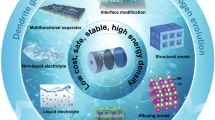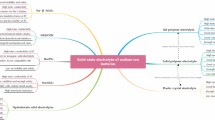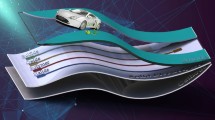Abstract
K-ion battery (KIB) is a new-type energy storage device that possesses potential advantages of low-cost and abundant resource of potassium. To develop advanced electrode materials for accommodating the large size and high activity of potassium ion is of great interests. Herein, a segment-like antimony (Sb) nanorod encapsulated in hollow carbon tube electrode material (Sb@HCT) was prepared. Beneficial from the virtue of abundant nitrogen doping in carbon tube, one-dimensional and hollow structure advantages, Sb@HCT exhibits excellent potassium storage properties: in the case of potassium bis(fluorosulfonyl)imide (KFSI) electrolyte, Sb@HCT displays a reversible capacity of up to 453.4 mAh·g−1 at a current density of 0.5 A·g−1 and good rate performance (a capacity of 211.5 mAh·g−1 could be achieved at an ultrahigh rate of 5 A·g−1). Additionally, Sb@HCT demonstrates excellent long-cycle stability at a current density of 2 A·g−1 over 120 cycles. Meanwhile, electrolyte optimization is an effective strategy for greatly improving electrochemical performance. Through ex-situ characterizations, we disclosed the potassiation of Sb anode is quite reversible and undergoes multistep processes, combining solid solution reaction and two-phase reaction.

Similar content being viewed by others
References
Tarascon, J. M.; Armand, M. Issues and challenges facing rechargeable lithium batteries. Nature 2001, 414, 359–367.
Mai, L. Q.; Yan, M. Y.; Zhao, Y. L. Track batteries degrading in real time. Nature 2017, 546, 469–470.
Goodenough, J. B.; Kim, Y. Challenges for rechargeable Li batteries. Chem. Mater. 2010, 22, 587–603.
Zhou, H. J.; Zhao, H. B.; Zhang, X.; Cheng, H. W.; Lu, X. G.; Xu, Q. Facile one-step synthesis of Cu2O@Cu sub-microspheres composites as anode materials for lithium ion batteries. J. Mater. Sci. Technol. 2018, 34, 1085–1090.
Wu, G.; More, K. L.; Xu, P.; Wang, H. L.; Ferrandon, M.; Kropf, A. J.; Myers, D. J.; Ma, S. G.; Johnston, C. M.; Zelenay, P. A carbon-nanotube-supported graphene-rich non-precious metal oxygen reduction catalyst with enhanced performance durability. Chem. Commun. 2013, 49, 3291–3293.
Jiao, Y. C.; Han, D. D.; Ding, Y.; Zhang, X. F.; Guo, G. N.; Hu, J. H.; Yang, D.; Dong, A. G. Fabrication of three-dimensionally interconnected nanoparticle superlattices and their lithium-ion storage properties. Nature Commun. 2015, 6, 6420.
Gao, H.; Zhou, T. F.; Zheng, Y.; Zhang, Q.; Liu, Y. Q.; Chen, J.; Liu, H. K.; Guo, Z. P. CoS quantum dot nanoclusters for high-energy potassium-ion batteries. Adv. Funct. Mater. 2017, 27, 1702634.
Luo, W.; Calas, A.; Tang, C. J.; Li, F.; Zhou, L.; Mai, L. Q. Ultralong Sb2Se3 nanowire-based free-standing membrane anode for lithium/sodium ion batteries. ACS Appl. Mater. Interfaces 2016, 8, 35219–35226.
He, Y. Z.; Han, X. J.; Du, Y. C.; Song, B.; Zhang, B.; Zhang, W.; Xu, P. Conjugated polymer-mediated synthesis of sulfur- and nitrogen-doped carbon nanotubes as efficient anode materials for sodium ion batteries. Nano Res. 2018, 11, 2573–2585.
Lakshmi, V.; Chen, Y.; Mikhaylov, A. A.; Medvedev, A. G.; Sultana, I.; Rahman, M. M.; Lev, O.; Prikhodchenko, P. V.; Glushenkov, A. M. Nanocrystalline SnS2 coated onto reduced graphene oxide: Demonstrating the feasibility of a non-graphitic anode with sulfide chemistry for potassium-ion batteries. Chem. Commun. 2017, 53, 8272–8275.
Slater, M. D.; Kim, D.; Lee, E.; Johnson, C. S. Sodium-ion batteries. Adv. Funct. Mater. 2013, 23, 947–958.
Wang, X. P.; Xu, X. M.; Niu, C. J.; Meng, J. S.; Huang, M.; Liu, X.; Liu, Z.; Mai, L. Q. Earth abundant Fe/Mn-based layered oxide interconnected nanowires for advanced K-ion full batteries. Nano Lett. 2017, 17, 544–550.
Zhang, W. C.; Mao, J. F.; Li, S. A.; Chen, Z. X.; Guo, Z. P. Phosphorusbased alloy materials for advanced potassium-ion battery anode. J. Am. Chem. Soc. 2017, 139, 3316–3319.
McCulloch, W. D.; Ren, X. D.; Yu, M. Z.; Huang, Z. J.; Wu, Y. Y. Potassium-ion oxygen battery based on a high capacity antimony anode. ACS Appl. Mater. Interfaces 2015, 7, 26158–26166.
Han, C. H.; Han, K.; Wang, X. P.; Wang, C. Y.; Li, Q.; Meng, J. S.; Xu, X. M.; He, Q.; Luo, W.; Wu, L. M. et al. Three-dimensional carbon network confined antimony nanoparticle anodes for high-capacity K-ion batteries. Nanoscale 2018, 10, 6820–6826.
Xie, Y. H.; Chen, Y.; Liu, L.; Tao, P.; Fan, M. P.; Xu, N.; Shen, X. W.; Yan, C. L. Ultra-high pyridinic N-doped porous carbon monolith enabling high-capacity K-ion battery anodes for both half-cell and full-cell applications. Adv. Mater. 2017, 29, 1702268.
Naguib, M.; Adams, R. A.; Zhao, Y. P.; Zemlyanov, D.; Varma, A.; Nanda, J.; Pol, V. G. Electrochemical performance of MXenes as K-ion battery anodes. Chem. Commun. 2017, 53, 6883–6886.
Wang, X. P.; Han, K.; Wang, C. Y.; Liu, Z. A; Xu, X. M.; Huang, M.; Hu, P.; Meng, J. S.; Li, Q.; Mai, L. Q. Graphene oxide-wrapped dipotassium terephthalate hollow microrods for enhanced potassium storage. Chem. Commun. 2018, 54, 11029–11032.
Jian, Z. L.; Luo, W.; Ji, X. L. Carbon electrodes for K-ion batteries. J. Am. Chem. Soc. 2015, 137, 11566–11569.
Xue, L. G.; Li, Y. T.; Gao, H. C.; Zhou, W. D.; Lü, X. J.; Kaveevivitchai, W.; Manthiram, A.; Goodenough, J. B. Low-cost high-energy potassium cathode. J. Am. Chem. Soc. 2017, 139, 2164–2167.
Zhang, Q.; Mao, J. F.; Pang, W. K.; Zheng, T.; Sencadas, V.; Chen, Y. Z.; Liu, Y. J.; Guo, Z. P. Boosting the potassium storage performance of alloybased anode materials via electrolyte salt chemistry. Adv. Energy Mater. 2018, 8, 1703288.
Okoshi, M.; Yamada, Y.; Komaba, S.; Yamada, A.; Nakai, H. Theoretical analysis of interactions between potassium ions and organic electrolyte solvents: A comparison with lithium, sodium, and magnesium ions. J. Electrochem. Soc. 2017, 164, A54–A60.
Sultana, I.; Ramireddy, T.; Rahman, M. M.; Chen, Y.; Glushenkov, A. M. Tin-based composite anodes for potassium-ion batteries. Chem. Commun. 2016, 52, 9279–9282.
Lei, K. X.; Wang, C. C.; Liu, L. J.; Luo, Y. W.; Mu, C. N.; Li, F. J.; Chen, J. A porous network of bismuth used as the anode material for high-energydensity potassium-ion batteries. Angew. Chem., Int. Ed. 2018, 130, 4777–4781.
Wang, W.; Zhou, J. H.; Wang, Z. P.; Zhao, L. Y.; Li, P. H.; Yang, Y.; Yang, C.; Huang, H. X.; Guo, S. J. Short-range order in mesoporous carbon boosts potassium-ion battery performance. Adv. Energy Mater. 2018, 8, 1701648.
Zhao, J.; Zou, X. X.; Zhu, Y. J.; Xu, Y. H.; Wang, C. S. Electrochemical intercalation of potassium into graphite. Adv. Funct. Mater. 2016, 26, 8103–8110.
Luo, W.; Wan, J. Y.; Ozdemir, B.; Bao, W. Z.; Chen, Y. N.; Dai, J. Q.; Lin, H.; Xu, Y.; Gu, F.; Barone, V. et al. Potassium ion batteries with graphitic materials. Nano Lett. 2015, 15, 7671–7677.
Gao, Y.; Yi, R.; Li, Y. C.; Song, J. X.; Chen, S. R.; Huang, Q. Q.; Mallouk, T. E.; Wang, D. H. General method of manipulating formation, composition, and morphology of solid-electrolyte interphases for stable Li-alloy anodes. J. Am. Chem. Soc. 2017, 139, 17359–17367.
Lei, K. X.; Li, F. J.; Mu, C. N.; Wang, J. B.; Zhao, Q.; Chen, C. C.; Chen, J. High K-storage performance based on the synergy of dipotassium terephthalate and ether-based electrolytes. Energy Environ. Sci. 2017, 10, 552–557.
Madec, L.; Gabaudan, V.; Gachot, G.; Stievano, L.; Monconduit, L.; Martinez, H. Paving the way for K-ion batteries: Role of electrolyte reactivity through the example of Sb-based electrodes. ACS Appl. Mater. Interfaces 2018, 10, 34116–34122.
Fan, X. L.; Chen, L.; Ji, X.; Deng, T.; Hou, S.; Chen, J.; Zheng, J.; Wang, F.; Jiang, J. J.; Xu, K. et al. Highly fluorinated interphases enable high-voltage Li-metal batteries. Chem 2018, 4, 174–185.
Fan, L.; Chen, S. H.; Ma, R. F.; Wang, J.; Wang, L. L.; Zhang, Q. F.; Zhang, E. J.; Liu, Z. M.; Lu, B. G. Ultrastable potassium storage performance realized by highly effective solid electrolyte interphase layer. Small 2018, 14, 1801806.
Luo, W.; Li, F.; Gaumet, J. J.; Magri, P.; Diliberto, S.; Zhou, L.; Mai, L. Q. Bottom-up confined synthesis of nanorod-in-nanotube structured Sb@N-C for durable lithium and sodium storage. Adv. Energy Mater. 2018, 8, 1703237.
Xiong, X. H.; Wang, G. H.; Lin, Y. W.; Wang, Y.; Ou, X.; Zheng, F. H.; Yang, C. H.; Wang, J. H.; Liu, M. L. Enhancing sodium ion battery performance by strongly binding nanostructured Sb2S3 on sulfur-doped graphene sheets. ACS Nano 2016, 10, 10953–10959.
Luo, W.; Zhang, P. F.; Wang, X. P.; Li, Q. D.; Dong, Y. F.; Hua, J. C.; Zhou, L.; Mai, L. Q. Antimony nanoparticles anchored in three-dimensional carbon network as promising sodium-ion battery anode. J. Power Sources 2016, 304, 340–345.
McGuire, K.; Lowhorn, N. D.; Tritt, T. M.; Rao, A. M. Raman scattering in doped transition metal pentatellurides. J. Appl. Phys. 2002, 92, 2524–2527.
Wang, S.; Yuan, S.; Yin, Y. B.; Zhu, Y. H.; Zhang, X. B.; Yan, J. M. Green and facile fabrication of MWNTs@Sb2S3@PPy coaxial nanocables for high-performance Na-ion batteries. Part. Part. Syst. Char. 2016, 33, 493–499.
Fu, L. J.; Tang, K.; Song, K. P.; van Aken, P. A.; Yu, Y.; Maier, J. Nitrogen doped porous carbon fibres as anode materials for sodium ion batteries with excellent rate performance. Nanoscale 2014, 6, 1384–1389.
Shen, W.; Wang, C.; Xu, Q. J.; Liu, H. M.; Wang, Y. G. Nitrogen-dopinginduced defects of a carbon coating layer facilitate Na-storage in electrode materials. Adv. Energy Mater. 2015, 5, 1400982.
Darwiche, A.; Marino, C.; Sougrati, M. T.; Fraisse, B.; Stievano, L.; Monconduit, L. Better cycling performances of bulk Sb in Na-ion batteries compared to Li-ion systems: An unexpected electrochemical mechanism. J. Am. Chem. Soc. 2012, 134, 20805–20811.
He, M.; Kravchyk, K.; Walter, M.; Kovalenko, M. V. Monodisperse antimony nanocrystals for high-rate Li-ion and Na-ion battery anodes: Nano versus bulk. Nano Lett. 2014, 14, 1255–1262.
Su, D. W.; Dou, S. X.; Wang, G. X. Bismuth: A new anode for the Na-ion battery. Nano Energy 2015, 12, 88–95.
Yi, Z.; Lin, N.; Zhang, W. Q.; Wang, W. W.; Zhu, Y. C.; Qian, Y. T. Preparation of Sb nanoparticles in molten salt and their potassium storage performance and mechanism. Nanoscale 2018, 10, 13236–13241.
Tzolov, M. B.; Iliev, M. N. Raman scattering from monoalkali (Na-Sb and K-Sb), bialkali (Na-K-Sb) and multialkali (Na-K-Sb-Cs) photocathodes. Thin Solid Films 1992, 213, 99–102.
Acknowledgements
We thank Prof. Hans-Eckhardt Schaefer (Stuttgart University) for stimulating discussions and English editing of the manuscript. This work was supported by the National Natural Science Foundation of China (No. 51832004), the National Natural Science Fund for Distinguished Young Scholars (No. 51425204), the National Key R&D Program of China (No. 2016YFA0202603), the Programme of Introducing Talents of Discipline to Universities (No. B17034), and the Yellow Crane Talent (Science & Technology) Program of Wuhan City.
Author information
Authors and Affiliations
Corresponding author
Electronic supplementary material
12274_2019_2335_MOESM1_ESM.pdf
Encapsulating segment-like antimony nanorod in hollow carbon tube as long-lifespan, high-rate anodes for rechargeable K-ion batteries
Rights and permissions
About this article
Cite this article
Luo, W., Li, F., Zhang, W. et al. Encapsulating segment-like antimony nanorod in hollow carbon tube as long-lifespan, high-rate anodes for rechargeable K-ion batteries. Nano Res. 12, 1025–1031 (2019). https://doi.org/10.1007/s12274-019-2335-6
Received:
Revised:
Accepted:
Published:
Issue Date:
DOI: https://doi.org/10.1007/s12274-019-2335-6




